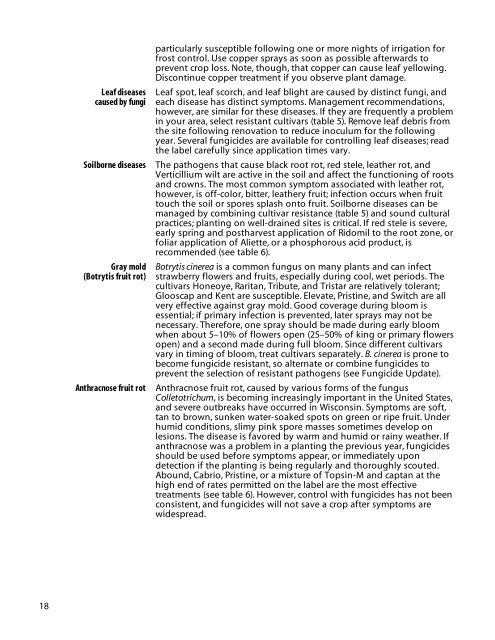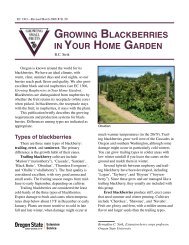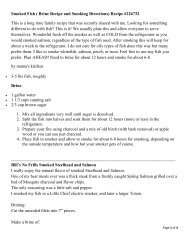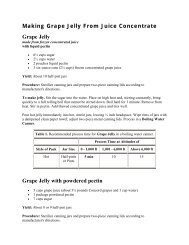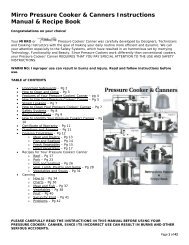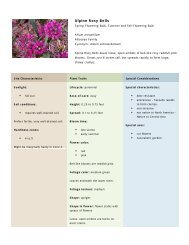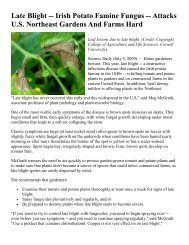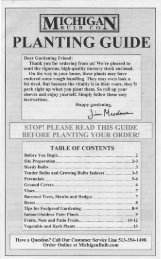Strawberry and Raspberry Pest Management in Wisconsin
Strawberry and Raspberry Pest Management in Wisconsin
Strawberry and Raspberry Pest Management in Wisconsin
You also want an ePaper? Increase the reach of your titles
YUMPU automatically turns print PDFs into web optimized ePapers that Google loves.
18<br />
Leaf diseases<br />
caused by fungi<br />
particularly susceptible follow<strong>in</strong>g one or more nights of irrigation for<br />
frost control. Use copper sprays as soon as possible afterwards to<br />
prevent crop loss. Note, though, that copper can cause leaf yellow<strong>in</strong>g.<br />
Discont<strong>in</strong>ue copper treatment if you observe plant damage.<br />
Leaf spot, leaf scorch, <strong>and</strong> leaf blight are caused by dist<strong>in</strong>ct fungi, <strong>and</strong><br />
each disease has dist<strong>in</strong>ct symptoms. <strong>Management</strong> recommendations,<br />
however, are similar for these diseases. If they are frequently a problem<br />
<strong>in</strong> your area, select resistant cultivars (table 5). Remove leaf debris from<br />
the site follow<strong>in</strong>g renovation to reduce <strong>in</strong>oculum for the follow<strong>in</strong>g<br />
year. Several fungicides are available for controll<strong>in</strong>g leaf diseases; read<br />
the label carefully s<strong>in</strong>ce application times vary.<br />
Soilborne diseases The pathogens that cause black root rot, red stele, leather rot, <strong>and</strong><br />
Verticillium wilt are active <strong>in</strong> the soil <strong>and</strong> affect the function<strong>in</strong>g of roots<br />
<strong>and</strong> crowns. The most common symptom associated with leather rot,<br />
however, is off-color, bitter, leathery fruit; <strong>in</strong>fection occurs when fruit<br />
touch the soil or spores splash onto fruit. Soilborne diseases can be<br />
managed by comb<strong>in</strong><strong>in</strong>g cultivar resistance (table 5) <strong>and</strong> sound cultural<br />
practices; plant<strong>in</strong>g on well-dra<strong>in</strong>ed sites is critical. If red stele is severe,<br />
early spr<strong>in</strong>g <strong>and</strong> postharvest application of Ridomil to the root zone, or<br />
foliar application of Aliette, or a phosphorous acid product, is<br />
recommended (see table 6).<br />
Gray mold<br />
(Botrytis fruit rot)<br />
Botrytis c<strong>in</strong>erea is a common fungus on many plants <strong>and</strong> can <strong>in</strong>fect<br />
strawberry flowers <strong>and</strong> fruits, especially dur<strong>in</strong>g cool, wet periods. The<br />
cultivars Honeoye, Raritan, Tribute, <strong>and</strong> Tristar are relatively tolerant;<br />
Glooscap <strong>and</strong> Kent are susceptible. Elevate, Prist<strong>in</strong>e, <strong>and</strong> Switch are all<br />
very effective aga<strong>in</strong>st gray mold. Good coverage dur<strong>in</strong>g bloom is<br />
essential; if primary <strong>in</strong>fection is prevented, later sprays may not be<br />
necessary. Therefore, one spray should be made dur<strong>in</strong>g early bloom<br />
when about 5–10% of flowers open (25–50% of k<strong>in</strong>g or primary flowers<br />
open) <strong>and</strong> a second made dur<strong>in</strong>g full bloom. S<strong>in</strong>ce different cultivars<br />
vary <strong>in</strong> tim<strong>in</strong>g of bloom, treat cultivars separately. B. c<strong>in</strong>erea is prone to<br />
become fungicide resistant, so alternate or comb<strong>in</strong>e fungicides to<br />
prevent the selection of resistant pathogens (see Fungicide Update).<br />
Anthracnose fruit rot Anthracnose fruit rot, caused by various forms of the fungus<br />
Colletotrichum, is becom<strong>in</strong>g <strong>in</strong>creas<strong>in</strong>gly important <strong>in</strong> the United States,<br />
<strong>and</strong> severe outbreaks have occurred <strong>in</strong> Wiscons<strong>in</strong>. Symptoms are soft,<br />
tan to brown, sunken water-soaked spots on green or ripe fruit. Under<br />
humid conditions, slimy p<strong>in</strong>k spore masses sometimes develop on<br />
lesions. The disease is favored by warm <strong>and</strong> humid or ra<strong>in</strong>y weather. If<br />
anthracnose was a problem <strong>in</strong> a plant<strong>in</strong>g the previous year, fungicides<br />
should be used before symptoms appear, or immediately upon<br />
detection if the plant<strong>in</strong>g is be<strong>in</strong>g regularly <strong>and</strong> thoroughly scouted.<br />
Abound, Cabrio, Prist<strong>in</strong>e, or a mixture of Tops<strong>in</strong>-M <strong>and</strong> captan at the<br />
high end of rates permitted on the label are the most effective<br />
treatments (see table 6). However, control with fungicides has not been<br />
consistent, <strong>and</strong> fungicides will not save a crop after symptoms are<br />
widespread.


